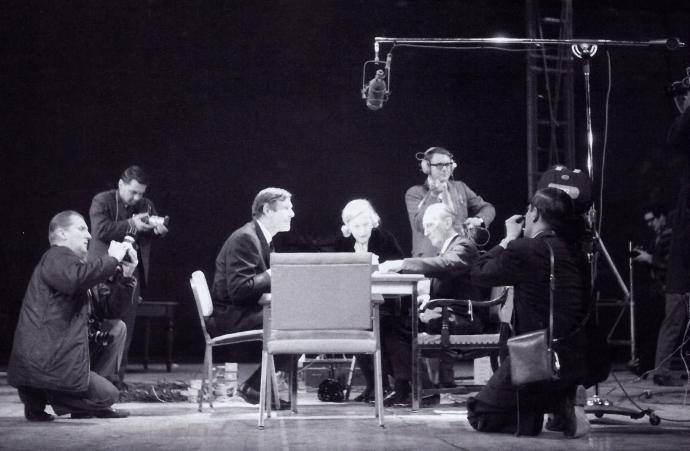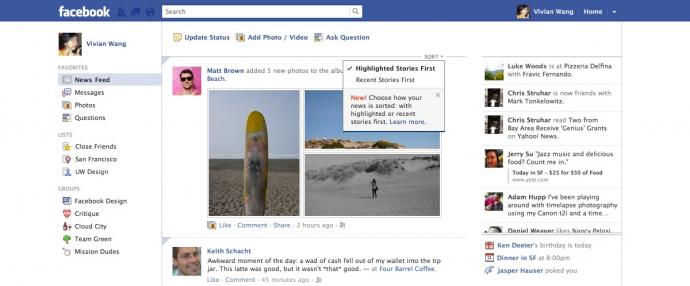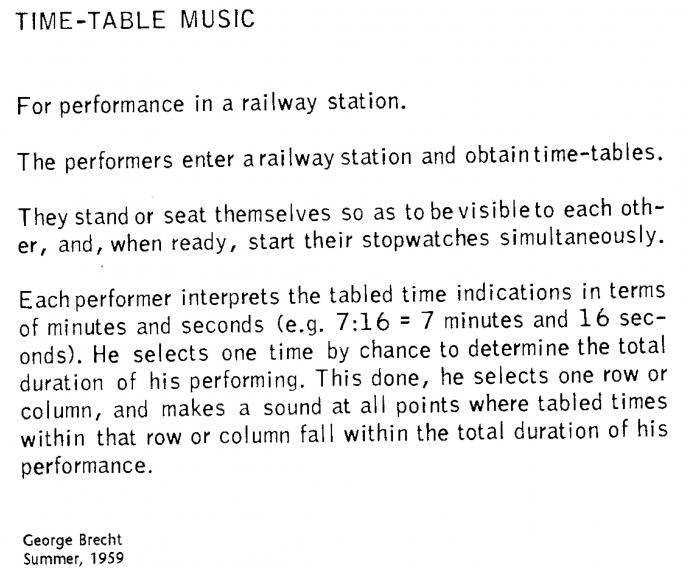from pastelegram.org, June 2011 – April 2014
Everyday Algorithms
Reunion
On the evening of March 5, 1968, John Cage sat down to play a game of chess with Marcel Duchamp. A bottle of wine sat on the table between them. Duchamp smoked a cigar, Cage a cigarette. Duchamp’s wife Teeny sat next to her husband observing the game. There was a small hole in the center of each square on the chessboard, and a tangle of cables ran from the side of the board to a stack of small boxes on the floor. A bright spotlight poured down on the players, while an audience of several hundred looked on from their seats in the theater.

John Cage, Marcel Duchamp and Teeny Duchamp, Reunion, 1968; chess game on sounding board; photographed by Shigeko Kubota.1
As the gameplay commenced, sounds emanated from eight speakers placed evenly around the theater. The holes in the chessboard contained photoresistors, which controlled the flow of music from “sound-generating systems” prepared and operated by four composers (David Behrman, Lowell Cross, Gordon Mumma and David Tudor). Each composer could send up to four channels of audio into the mixer. Depending on the arrangement of pieces on the board (i.e. the amount of light received by each of the sixty-four photoresistors), these sixteen channels variously turned on or off, and moved from speaker to speaker. Lowell Cross, who designed and built the chessboard, later wrote that his arrangement of the circuits “was arbitrary, unplanned and quasi-random, but any of the sixteen inputs had a ‘chance’ of appearing in as many as four of the eight loudspeaker locations surrounding the audience.”2
Cross, with some general guidance from Cage, had created an algorithm for mixing music according to sixty-four variables, though their values had nothing to do with music. More importantly, he had created a system for turning a chess game into a concert, a quotidian exercise into high theater. These themes come up throughout Cage’s career. Starting in the 1940s, he used the I Ching (an ancient Chinese divination system containing sixty-four hexagrams) to produce Music of Changes and other works. In the 80s he enlisted composer and programmer Andrew Culver to write a DOS program replicating the chance operations of the I Ching. The parameters of this program indicate a sophisticated understanding of chance on Cage’s part; the user can introduce varying degrees of “fixed bias” and “movable bias” into the algorithm to constrain the randomization.3
Despite Duchamp’s handicap of a knight, the aging artist won the first game handily in less than half an hour. Much of the audience (including Marshall McLuhan) left at this point. The next game, between Cage and Teeny Duchamp, lasted several hours and remained unresolved when the players retired at 1 a.m. (Teeny eventually won when they picked the game back up a few days later.)
Cage called this work Reunion, and while the music it produced did not receive critical acclaim, as a concept it bound together many of the artist’s most significant contributions. In Brandon LaBelle’s reading of Cage, he “addressed the very act of making decisions, the artist being understood as not so much the maker of objects but as an individual in the act of making decisions as to what, how, and where art takes place and the systems by which to initiate its production.” 4 The crux of Reunion was in the decision to allow the unfolding of a chess game determine the course of a performance. Those producing the music had no control over when or whether it would be heard by the audience, and neither did Cage or Duchamp. Although the performers understood the function and meaning of the system, their control over it was oblique at best.
This approach, which was expanded and permuted by Cage’s collaborators and students, leads to “a point where [art] loses its objectness, as an ordered form, collapsing from its own inertia onto the field of the everyday—aesthetics not of refined formalism but of cultural energy.”5 Following Cage, artists like George Brecht and Alison Knowles wrote event scores, instructions for performances that could be realized in streets and subways or on kitchen counters. Many of these, too, could be considered algorithms, though they usually left much room for interpretation and improvisation. Sol LeWitt did the same with wall drawings based on sets of textual instructions. Cage’s use of algorithms, of setting up pseudo-mechanical processes to produce art, removes (much of) the creator’s intentionality from the object but puts the artist in control of the system. It effectively reveals and abstracts the creative process.
Not just the creative process but the structures within which it operates. Cage would ask whether harmonic structures should dominate musical composition. Whether the audience should be separated from the performers. Whether a pianist should play only on the keys of the piano. Whether a radio should be excluded from the realm of musical instruments. He transparently operated in the realm of structure and process—he deconstructed the mores of art making.
EdgeRank
Facebook’s identity today is closely tied to its News Feed application (often referred to simply as “feed”), but this wasn’t always the case. Outside critics actually considered the feed a risky gamble when Facebook introduced it in September of 2006. Before the advent of the personal feed, users had to click around to the profiles of all their individual friends, generating lots of page views (an important metric for advertisers). With the News Feed, users could now see activity from all their friends in one place. Software engineer Ruchi Sanghvi, discussing the genesis of the feed, described its vast ambition: “We were convinced that if we launched News Feed, not only would we change user behavior on the site, we would change users’ navigation patterns on the Web.” 6
Facebook’s News Feed was the first large-scale application to generate a personal “newspaper” of activity in the lives of each user’s social network. In other words, it blurs the boundary between news and life, and also the boundary between author and audience. The allure was overwhelming: after feed launched, users spent twice as much time on the site, viewing more photos and more user profiles than ever before.
By the spring of 2009, feed had moved to a real-time model, updating constantly and creating what Sanghvi calls a “virtuous cycle of sharing.” The basis of this cycle lies in the fact that “as the Web becomes more and more open, people aren’t afraid of being narcissistic. I want to be heard. I want to know that people out there are listening to my opinions. So the secret to the virtuous cycle of sharing is that when users upload content, they know that it’s going to be distributed virally. And not only is it being distributed, they are receiving positive reinforcement.”8 This positive reinforcement takes the form of likes and comments, which in turn spawn their own stories in other feeds.
Facing a dramatic increase in content, the engineers working on News Feed hit upon a final problem: how to make sure that users see the most interesting stories created by their friends. To meet this challenge, they developed an algorithm called EdgeRank, which essentially calculates the affinity between two users (the author and the viewer) and multiplies it by the recency of the post and the number of likes and comments it has received from other users. The higher a post scores in this equation, the more likely it is to show up in an individual’s feed. Of course, EdgeRank is more complex than this. It adjusts to each user’s behavior. If you login to the system rarely and have many friends, it is likely to show you only the most important posts by your closest friends. If you check in throughout the day, you’ll see a greater variety of information from more sources.
EdgeRank keeps a record of how each user interacts with content on Facebook (each interaction is an “edge”), and through an invisible karmic system determines what she will see. With your clicks today you edit the newspaper you will open tomorrow — alongside your friends, who are also liking and commenting, and a team of software engineers periodically tinkering with the feed’s behavior. Now the boundary between editor, author and audience is fully obscured, each role feeding back into the others, controlled by the invisible hand of the algorithm.
The newsroom editor is replaced by a system that produces a constant flow of news; one might say a news not of refined formalism but of cultural energy. There are some striking similarities between the way that Cage and his followers approached the production of art and the way that Facebook approaches production of news. Quotidian actions and objects form most of the content, which is then mixed into a rough pastiche by an algorithm. Chance operations appear to be driving the system, encouraging improvisation and an almost frictionless, constant creative output. For many Facebook is a seamless part of everyday life and a primary creative outlet.
Is News Feed an event score?
The comparison between Facebook’s social environment and a Cage performance or Fluxus happening has its limitations. But the places where the comparison breaks down may be the most fertile territory to explore.
The participants in a Fluxus happening are usually well aware of the algorithm that is shaping the event, and their role in the process. Indeed they are internalizing the process, incorporating their minds and bodies into a temporary social order. A Facebook user isn’t told—and never really understands—the impact of clicking the Like button or leaving a comment (though the general principles of EdgeRank are public knowledge, its inner workings are not). She doesn’t know what’s being filtered out of her feed by the algorithm, because the filter is quite intentionally opaque. This is the source of Eli Pariser’s concerns about Facebook’s and Google’s personal filters (see The Filter Bubble9): If the scope of our information field is being narrowed algorithmically based on our likes, will we be forced into a state of isolation from views which differ from our own?
It’s not just the effects of the algorithm that are troubling. It is important to occasionally be reminded of the simple fact that there is a set of firm rules governing the social dynamic. This is where Cage and the Fluxus artists excelled. There have always been mores that control the flow of information and potential avenues of personal expression. In events like Reunion and Yoko Ono’s Cut Piece, the artists created their own systems of behavior. They are crude compared to the delicate and complex social order developed by human societies over millennia — and even compared to the algorithms developed at Facebook over the last six years. But they have the advantage of being explicit, and their very crudeness forces a higher level of awareness in participants.
In the crudeness sense News Feed is not an event score. But this points to another possibility. News Feed is simply an app, central though it may be, built on the Facebook Platform. An artist-programmer could build something like it, but more explicit, more experimental, more disruptive: an app designed in the spirit of Cage and the Fluxus artists, which makes the impact of social networking software explicit, which sharpens awareness of what News Feed is, how it obstructs and magnifies our messages. It could be awkward, absurd, almost unusable, as long as its algorithms are painfully transparent. We need artists invading this social space, not content to post invitations to their openings, but pulling it apart at the seams.
This article is part of "Unsound,” edited by Barbara Perea. Other parts of this project include:
As Slow as (Inhumanly) Possible: Meditations on Time by Barbara Perea
Unsound, an online exhibition curated by Barbara Perea
Two Ships Passing: Barbara Perea in conversation with Nick Hennies
Trucks passing by music by Barbara Perea
and our editor’s statement
- 1. Though this image is subject to copyright, its use is covered by U.S. fair use laws because it constitutes an important visual depiction of the article's subject. Moreover, it is a low resolution image unsuitable for the production of copyright goods.
- 2. Lowell Cross, “Reunion: John Cage, Marcel Duchamp, Electronic Music and Chess,” Leonard Music Journal 9 (1999): 38.
- 3. Warren Burt, “Culver and Cage’s IC — Bias, Immobile, and No Bias,” self-published (2010): 3. http://www.warrenburt.com/storage/CageBiasImmobileNoBias.pdf
- 4. Brandon LaBelle, Background Noise: Perspectives on Sound Art (Continuum Publishing Group, 2006): 54.
- 5. LaBelle, 2006.
- 6. Ruchi Sanghvi, “Focus on Feed,” f8 Conference, April 21, 2010: 3:20. http://www.livestream.com/f8techniques/video?clipId=pla_5219ce25-53c6-40...
- 7. As far as we can tell, this is a non-copyrighted stock image.
- 8. Sangvhi, 6:20.
- 9. Eli Pariser. The Filter Bubble (New York: Penguin Press, 2011.
- 10. Though this image is subject to copyright, its use is covered by U.S. fair use laws because it constitutes an important visual depiction of the article's subject. Moreover, it is a low resolution image unsuitable for the production of copyright goods.

